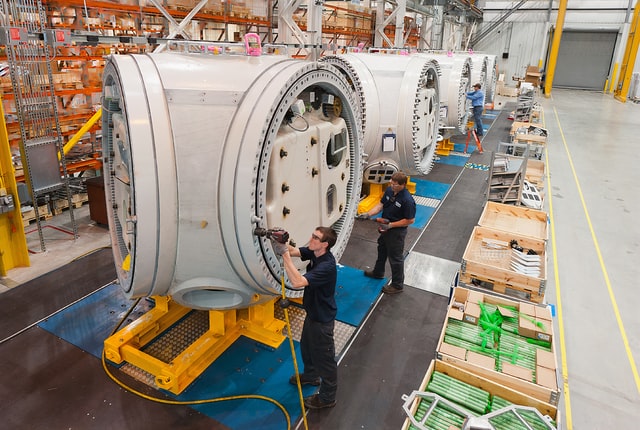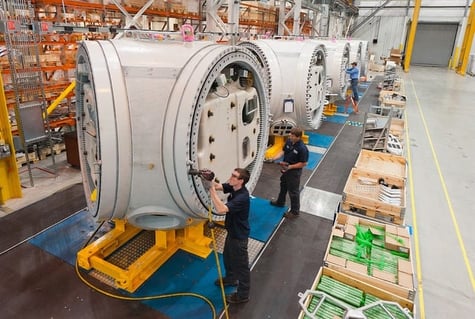Prevent It


Why Proactive Manufacturing Ergonomics Are Effective at Reducing Injuries
 Workers of all ages can develop musculoskeletal disorders (MSDs) from overexertion, lifting heavy items, bending/stretching, and working in awkward positions. These disorders develop gradually over time or appear suddenly from straining to complete specific tasks.
Workers of all ages can develop musculoskeletal disorders (MSDs) from overexertion, lifting heavy items, bending/stretching, and working in awkward positions. These disorders develop gradually over time or appear suddenly from straining to complete specific tasks.
A person's musculoskeletal system can be adversely affected by poor workplace conditions such as high-intensity activity, extreme temperatures, or repetitive movement, leading to tired and hurting employees. If performing a job task causes physical discomfort, the worker may not be able to do it properly, impacting quality and increasing costs.
Work-related MSDs are a significant contributor to absenteeism, lost productivity, and worker compensation claims. There are numerous ways to lower MSD risks.
Ergonomic Challenges in Manufacturing
Manufacturing workers are especially prone to MSD injury. Their jobs typically include performing repetitive tasks, strenuous activity, and handling materials. Workers may also be exposed to heavy vibrations from machinery and tools.
Highly repetitive tasks are a key contributor to carpal tunnel syndrome and tendonitis. And manual materials handling can impact the entire body, not just the back and shoulders. While these tasks may be essential, manufacturers can help workers do them more safely using ergonomics.
Reducing MSDs with Workplace Ergonomics
Ergonomics – the science of designing the workplace and job demands to suit workers' capabilities – can reduce the chance for MSDs. Workers come in all sizes, so matching job tasks to the individual's capabilities can help lessen muscle fatigue, minimize discomfort, and maximize safe work performance.
Wherever possible, organizations should help workers minimize highly repetitive tasks, reduce straining and awkward postures, and avoid heaving lifting. Redesigning the job to support good posture, or require fewer motions and less exertion, can make workers more comfortable and productive.
A proactive ergonomic process is part of a positive safety culture and uses the principles of workplace injury prevention programs to address MSD hazards. A successful ergonomic workplace program requires management commitment, worker participation enhanced with training, and ongoing evaluation/control of MSD risk factors. Rather than approaching ergonomics as a standalone project, manufacturers should view it as an ongoing process incorporated into day-to-day operations. An ongoing program will boost employee well-being and morale, contributing to a positive safety culture.
For example, in WorkWell's managed onsite programs, physical therapists regularly conduct safe work rounds looking at the tasks performed and matching them with the worker's capabilities or redesigning how the task is done to minimize injury risk and maximize quality and efficiency.
Tips for Designing an Ergonomic Workplace
Ergonomic solutions can take many forms, from modifying existing equipment, changing work practices, and/or acquiring new tools or devices to ease the production process. Updating workstations with lift-assist devices, chairs, transportation carts, even anti-fatigue floor mats can reduce unnecessary movements and the physical stress the job puts on a worker's body.
Implementing effective ergonomic programs requires understanding the work processes, job tasks, equipment, workplace layouts, and participation by both management and workers. Successful programs include:
1. Training employees on ergonomic topics and best practices;
2. Removing/minimizing workplace hazards;
3. Identifying and treating workers' early MSD symptoms before they worsen;
4. Implementing ergonomic solutions to alleviate worker discomfort;
5. Establishing, assessing, and reviewing corrective action procedures and policies.
Worker MSDs are not an inevitable cost of doing business. Using ergonomic principles, backed up with proper employee training and evaluation programs, you can decrease on-the-job injuries, reduce worker compensation claims, and improve the bottom line.
Select a topic
- View all topics
- WorkWell
- Safety Culture
- Onsite PT Clinics
- Ergonomics
- Injury/Illness Prevention
- Employee Wellness
- MSK
- Industry News
- POET
- Safety
- Managed Services
- Manufacturing
- Functional Job Descriptions
- Onsite PT
- FJD
- Post Offer Employment Training
- Provider Network
- Blog
- Events
- Featured
- OSHA
- Work Readiness
- Company News
- Job Coaching
- MSK Strategy
- Musculoskeletal
- PT Solutions Employee
- Presenteeism
- Push/Pull
- Recruitment
- Training
- Trust
- Worksite Rounds
Subscribe to Our Blog
Practical tips focused on workplace injury prevention.
Featured Posts
postsTags [BlogPost 178613021575 Shift to Prevention and End the Game of Whack-a-Mole, BlogPost 125116526205 Why now is the time for a Managed Onsite MSK Clinic]
.png)

